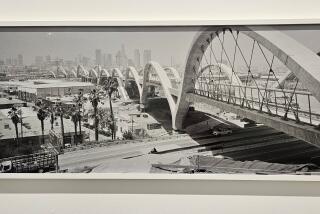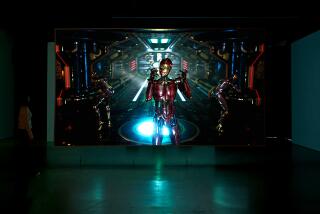Review: Cellist Maya Beiser and dancer Wendy Whelan in a 9/11 work like no other
Apple introduced the iPhone in 2007, six years after 9/11. Though two of the most significant American events this century, they are seldom connected. Doing so Friday at Royce Hall proved then all the more telling when Kristy Edmunds introduced the evening’s presentation by the Center for the Art of Performance at UCLA, which she administers.
She asked that we turn off our cellphones, not for the usual reason — that they are distracting to performers and other members of the audience. No, they are distracting to their owners. Just thinking about taking a photo, she said, prevents you from being in the moment, or in this case, in “The Day.”
This abstract new 60-minute performance piece for cellist Maya Beiser and ballerina Wendy Whelan, composed by David Lang and choreographed by Lucinda Childs, is like no other 9/11 work. You wouldn’t even know the 9/11 connection without reading Beiser’s program note or sticking around afterward for the Q&A with the four artists.
“The Day” is not a memorial. It is hardly a requiem, although it ends with Whelan gracefully rolling herself into a gauzy shroud, an affecting image that sticks for its sheer gorgeousness. “The Day” is not about yesterday, even if its text, crowd-sourced from the internet, serves to remind us of what plausibly might be a day in the life of dozens of everyman and everywoman victims of the terrorist attack on the World Trade Center. “The Day” may be slightly about tomorrow, in that Lang wondered what journey in the Bardo these souls may be on. Our job in the audience then became to wonder how we fill the holes they left behind.
Our phones, on the other hand, with their capacity for perpetual distraction, eagerly fill in holes for us, with insistent news feeds reminding us of topsy-turvy 9/11 journeys in the here and now. Somehow, while we weren’t paying attention, the New York mayor who had been the national voice of consolation during 9/11 is now a loose cannon in the middle of a presidential impeachment investigation. The consequences of the U.S. military responses to 9/11 have led to an unmanageable Middle East dominating the news. Saudi Arabia, which fostered 9/11 terrorists, this month was given more of our troops and weaponry.
To suggest a different 9/11 path to ponder, “The Day” needed its own passage. The beginning was Lang’s half-hour cello piece “world to come” (in other words, WTC), which he wrote for Beiser in wake of 9/11. He was walking his young children to school that morning and had to hurry them to safety as they witnessed the first plane strike the nearby World Trade Center. That half-hour solo, which uses additional recorded cello tracks and requires Beiser to include breathy vocals, moves in a contemplative arc. Melodic and harmonic patterns gradually grow into effusive room-filling cello sonorities, landing on satisfyingly somber repeated patterns in the manner of early Philip Glass.
Still haunted a decade later by his experience on 9/11, but also aware of how memory has its own lifespan, Lang wrote a prequel for Beiser. His style had changed, trusting more in the elemental. He used the same melodic material but let it expand without forcing. He further added a text to be read.
Searching the internet with the question, “I remember the day I …” Lang cataloged dozens of responses and then presented them in alphabetical order. The parade of quotidian experiences and emotions runs from the day “I achieved the perfect engineering drawing” to “I wrote my letter of resignation.”
After performing both works, Beiser chose to put them together and stage them. Childs’ dance for Whelan is a set of possibilities with, in the second part, her characteristic contrasts between static gestures and zealous speed. For the first part, imagery of the text led more to suggestions, with room for improvisation and ropes the dancer could use for visual indications of lines. Joshua Higgason added a backdrop of highly evocative projections, including a large industrial rehearsal space, and Sara Brown produced the elegant geometric set.
The prequel begins with dancer and cellist in white. Behind each performer is her image projected large. The sound design is also “large,” which is to say booming, unnatural but impressive. You know from the start that Beiser, who is a magnificent cellist, is going to fill not just your ears but also take over your senses.
The narrated remembrances come too fast for their imagery to stick. Whelan, who is bare-legged but with a flowing train and scarf, along with her various sticks and ropes, strikes poses that seem to make order out of fluidity, as disconnected experiences are read in monotone. “I first climbed a rope.” “I stumbled.” “I talked.” “I planted.” “I heard about his murder.” “I met the director.” “I took it a bit too far.” “I tried to demonstrate the action” — which Whelan didn’t, making it an all-the-more-powerful demonstration of her own action.
In the second half, Beiser and Whelan wear black. Large swaths of white curtain behind the stage fall like towers, maybe, or maybe just curtains blowing, like answers, in the wind. Without text and with a cello cathedral of sound, Whelan’s dance becomes more demonstrative (but still formal and restrained). A hint of the somber requires no loss of life affirmation.
In the end, this searching, haunting and very, very beautiful work is surprisingly lacking in melancholy. It is souls journeying, seen neither from the nostalgic past nor unknowable future. Rather than remembering the day something happened — the day, say, “I turned older” — it is the day we all turn older, every day.
More to Read
The biggest entertainment stories
Get our big stories about Hollywood, film, television, music, arts, culture and more right in your inbox as soon as they publish.
You may occasionally receive promotional content from the Los Angeles Times.







